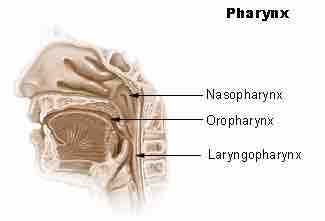The Pharynx
The human pharynx (plural: pharynges) is the part of the throat situated immediately posterior to the mouth and nasal cavity, and superior to the esophagus and larynx.
The human pharynx is divided into three sections: the nasopharynx (epipharynx), the oropharynx (mesopharynx), and the laryngopharynx (hypopharynx), which are all innervated by the pharyngeal plexus.
The pharynx is part of both the digestive system and the respiratory system. As a component of the upper respiratory tract, the pharynx is part of the conducting zone for air into the lungs. Therefore, one of its primary functions is to warm and humidify air before it reaches the lungs.

The three main sections of the pharynx
This figure illustrates the three main subdivisions of the pharynx.
The Nasopharynx
The nasopharynx is the upper region of the pharynx. It extends from the base of the skull to the upper surface of the soft palate above the oral cavity. The nasophaynx connects the nasal cavity with the throat.
The nasopharynx connects to the eustachian tubes of the middle ear, which allows the nasopharynx to help balance pressure within the ear. However, it also allows infections to spread easily between the nasopharynx and ear. The nasopharynx contains psuedo-stratified squamous cell epithelia tissue that is ciliated (covered in tiny hairs that move mucus).
The adenoids (pharyngeal tonsils) are a mass of lymphatic tissue found in the roof of the nasopharynx. The adenoids play a minor role in embyonic development and have a minor role in producing T-lymphocytes for the immune system after birth.
The adenoids are often removed in childhood due to infection or hypertrophy (enlargement of the cells in its tissues), which can obstruct the flow of air from the nose to the lung if left untreated. While loss of the adenoids does not make a significant difference in immune system function, the procedure occasionally has complications.
The lateral walls of the nasopharynx are made of the pharyngeal ostia (bone) of the auditory tube, and supported by the torus tubarus, a mound of cartilage tissue from the auditory tube. Two folds arise from the cartilaginous opening of the auditory tube.
The salpingopharyngeal fold is a vertical fold of mucous membrane extending from the inferior part of the torus and is made up of salpingopharyngeus muscle. The salpingopalatine fold is a smaller fold extending from the superior part of the torus to the palate; it contains the levator veli palatini muscle.
Behind the bone of the auditory tube is a deep recess, the pharyngeal recess. Above the adenoid, in the midline, is an irregular flask-shaped depression of the mucous membrane called the pharyngeal bursa.

The Pharynx
This is a detailed diagram of the pharynx from Gray's Anatomy, showing the major structures in each part of the pharynx.
The Oropharynx
The orpharnyx (mesopharynx) is the middle portion of the pharynx. It lies between the oral cavity, below the nasopharynx, and above the laryngopharynx, and has an opening to each of these other cavities. The anterior wall of the oropharynx consists of the base of the tongue and the superior wall consists of the bottom surface of the soft palate and the uvula.
The oropharynx is lined by non-keratinized squamous stratified epithelium, which is thicker than the epithelium found in other parts of the respiratory tract in order to prevent damage from food, but not as thick as skin as it lacks keratin.
The epiglottis lies between the oropharynx and the laryngopharynx, and it is a flap of elastic cartilage that closes during swallowing to ensure food enters the esophagus rather than the trachea.
The oropharynx contains the palatine tonsils, which are masses of lymphoid tissue found on the lateral walls of the oropharynx. Compared to the adenoids of the nasopharynx, the palatine tonsils contain many folds (called crypts), and aren't ciliated like the adenoids are. These tonsils are also occasionally removed in people with infection or enlargement.
The Laryngopharynx
The laryngopharynx or hypopharynx is the caudal part of the pharynx; it is the part of the throat that connects to the esophagus and trachea. It lies inferior to the epiglottis and marks the division between the respiratory and digestive system pathways.
During swallowing, the epiglottis closes over the trachea and air passage temporarily stops. The laryngopharynx naturally continues into the esophagus tissue and is made up of a similar type of stratified squamous epithelium tissue.
The layngopharynx itself has a few important demarcations and regions. The formal superior boundary that separates the laryngopharynx from the oropharynx is at the level of the hyoid bone.
The laryngopharynx includes three major regions: the pyriform sinus, the postcricoid area, and the posterior pharyngeal wall, which are separated by small folds of cartilage. Unlike the nasopharynx and oropharynx, there are no tonsils in the laryngopharynx.